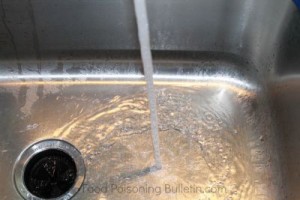“Consumers are the last line of defense in preventing foodborne illness for food prepared at home.” That line, from the study Consumer Vegetable and Fruit Washing Practices in the United States, 2006 and 2010, points out that it’s up to the consumer to avoid food poisoning by washing produce, cooking meats, fish, and eggs to the proper temperature, and avoiding cross-contamination.
 The FDA’s Center for Food Safety and Applied Nutrition (CFAN) conducted a telephone survey to ask consumers about their food washing habits. CFAN conducts this type of study every three to five years. The foods included in the survey were strawberries, tomatoes, cantaloupes, and bagged, pre-cut lettuce. Food safety experts recommend that all produce that is not pre-washed should be rinsed under running water. Produce with hard rinds should be scrubbed, and produce that is soft should be rubbed.
The FDA’s Center for Food Safety and Applied Nutrition (CFAN) conducted a telephone survey to ask consumers about their food washing habits. CFAN conducts this type of study every three to five years. The foods included in the survey were strawberries, tomatoes, cantaloupes, and bagged, pre-cut lettuce. Food safety experts recommend that all produce that is not pre-washed should be rinsed under running water. Produce with hard rinds should be scrubbed, and produce that is soft should be rubbed.
While rinsing will not remove all pathogens, it does reduce their numbers. Soaking, using produce cleaners, and using soap are not recommended, according to the study. Soaking is not as effective as running water, produce cleaners are “no more effective than water”, and soap and other chemicals can add contaminants to the food.
The study found that overall, “women, those with less-than-college-level education, and middle aged adults have the safest food-handling behaviors.”
Cantaloupes. There was a decline in the number of people who wash cantaloupes from 2006 to 2010. This study was conducted before the cantaloupe Listeria outbreak in the summer of 2011 that sickened more than 100 people and killed 35. But there was an outbreak of Salmonella Litchfield in cantaloupes in 2008.
The study found that there were significant differences in washing habits in race/ethnicity categories and some age and education subcategories. Fewer non-Hispanic black mean, hispanic men, and non-hispanic white men reported washing cantaloupes in 2010 than in 2006.
A 2006 study by the USDA’s Agricultural Research Service found that hot water immersion for cantaloupes can kill bacteria. That product is difficult to wash since its thick, webbed rind can hold bacteria. The cantaloupe is immersed in 168 degrees F. water for 3 minutes. This kills bacteria but doesn’t soften the flesh since it’s protected by the hard rind.
Lettuces. There was a significant increase in the number of consumers who wash bagged, pre-cut lettuce. Women in the 18 to 45 age group were more likely to wash this product in 2010 than in 2006. But food safety experts recommend that this product not be washed again. It is washed before bagging, and washing the product at home can introduce bacteria via cross-contamination.
The study found that Non-Hispanic Black and Hispanic Men and Hispanic women were more likely to wash bagged, pre-cut lettuce.
The study authors think that because of the 2006 recall and outbreak of E. coli 0157:H7 in raw spinach, consumers feel that product needs to be washed.
Strawberries and Tomatoes. Most consumers surveyed wash strawberries and tomatoes before serving. In fact, they were far more likely to wash these products than produce with a hard rind.
Education about safe food handling practices was the goal of this study. It’s clear that more education is needed regarding produce washing habits.
But what about washing poultry and other raw meats? Many consumers wash these products, even though food safety experts advise against it.
While brining meats and poultry is a recent practice, the salt used in brine does not kill bacteria. If the consumers chooses to brine raw meats and poultry, they must be careful to prevent cross-contamination when removing the meat from the brine and discarding the brine. And it’s important to refrigerate the meat and poultry when it’s in the brine solution.
Food Poisoning Bulletin asked Dr. Francisco Diez-Gonzalez of the University of Minnesota about the safe handling of poultry. He said, “washing chicken is a really bad idea. Not only would it spread bacteria, but washing is a very ineffective way to reduce contamination.”
Dr. Diez-Gonzales recommends these steps for handling raw poultry products:
- Use a cutting board for meats only to avoid cross-contamination.
- Clean and disinfect utensils that come in contact with raw meat.
- Wash hands frequently when handling raw chicken pieces.
- Cook it well, using a thermometer every single time, to a temperature of at leas 165 degrees F. This will kill pathogenic bacteria.
- Dispose of leftovers and packaging material carefully, avoiding any contact with other surfaces.




